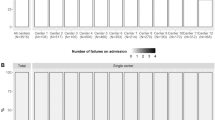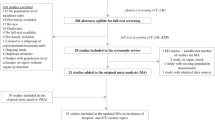Abstract
We develop a patient level hierarchical regression model using administrative claims data to assess mortality outcomes for a national VA population. This model, which complements more traditional process driven performance measures, includes demographic variables and disease specific measures of risk classified by Diagnostic Cost Groups (DCGs). Results indicate some ability to discriminate survivors and non-survivors with an area under the Receiver Operating Characteristic Curve (C-statistic) of .86. Observed to expected mortality ranges from .86 to 1.12 across predicted mortality deciles while Risk Standardized Mortality Rates (RSMRs) range from .76 to 1.29 across 145 VA hospitals. Further research is necessary to understand mortality variation which persists even after adjusting for case mix differences. Future work is also necessary to examine the role of personal behaviors on patient outcomes and the potential impact on population survival rates from changes in treatment policy and infrastructure investment.




Similar content being viewed by others
Notes
VA patients are assigned to hospital based primary care providers who are responsible, in theory, for the totality of care received.
There are 20 HCCs deemed to be ineligible for veterans, have been miscoded, or have fairly insubstantial numbers: HCCs 61–65 (Developmental Delay); HCC 107 (Cystic Fibrosis); HCC129 (ESRD Medicare eligible); HCCs 141–147 (Pregnancy); HCCs 168–172 (Neonate, Birth); and HCC 173 (Major Organ Transplant Procedure).
VA Registry programs are composed of patients with Spinal Cord Injury, Chronic Mental Illness, Post Traumatic Stress Disorder, Alcohol Dementia, Hepatitis C, Traumatic Brain Injury, AIDS, End Stage Renal Disease, or who are receiving long term care, domiciliary care, care at home, blind rehabilitation care, and care for a transplant or stroke.
Priority 1 veterans are those with service connected disabilities greater than 50%, Priority 2, 30–50%, and Priority 3, 20–30%. Priority 4 veterans are categorized as housebound or catastrophically disabled with a permanent, severely disabling injury or disease. Priority 5 veterans are those with incomes below the VA income means test or Medicaid eligible. Priority 6 veterans, used in these analyses as a comparison group, were exposed to Agent Orange or have illnesses associated with service in the Gulf War. Priority 7 veterans are non-service connected veterans who have incomes above the VA means test threshold and income below the HUD geographic index. Category 8 veterans are non-service connected veterans whose incomes are above the HUD geographic index. Priority 9 patients (largely non-veterans) are not included in the analysis.
Models were also estimated with both hospital and network random effects with inconsequential differences relative to hospital only random effect models, indicating very small network random effects.
According to the CDC/NCHS, the 2007 mortality rate for males in the general US population, age 20 and older, is approximately 1.1%, and for males aged 60 and older approximately 3.8%.
HCC 184 is used as the comparison group.
The estimate is the aggregate difference between the hospital specific expected mortality with and without random effects for those hospitals with an RSMR greater than one.
References
Porter M (2010) What is value in health care? NEJM 363(26):2477–2481
Fihn SD, Vaughan-Sarrazin M, Lowy E, Popescu I, Maynard C, Rosenthal GE, Sales AE, Rumsfeld J, Pineros S, McDonell MB, Helfrich CD, Rusch R, Jesse R, Almenoff P, Fleming B, Kussman M (2009) Declining mortality following acute myocardial infarction in the Department of Veterans Affairs health care system. BMC Cardiovasc Disord 9(44). doi:10.11861/1471-2261-9-44
Krumholz HM, Wang Y, Mattera JA, Wang Y, Han LF, Ingber MJ, Roman S, Normand ST (2006) An administrative claims model suitable for profiling hospital performance based on 30-day mortality rates among patients with an acute myocardial infarction. Circulation 113:1683–1692
Culler SD, Simon AW, Brown PP, Kugelmas AD, Reynolds MR, Rask KJ (2008) Sex differences in hospital risk-adjusted mortality rates for Medicare beneficiaries undergoing CABG surgery. Arch Intern Med 168(21):2317–2322
Gordon HS, Johnson ML, Wray NP, Petersen NJ, Hendersen WG, Khuri SF, Geraci JM (2005) Mortality after noncardiac surgery. Med Care 43(2):159–167
Hannan EL, Wu C, DeLong ER, Raudenbush SW (2005) Predicting risk-adjusted mortality for CABG surgery: Logistic versus hierarchical logistic models. Med Care 43(7):726–735
Chukmaitov AS, Bazzoli GJ, Harless DW, Hurley RE, Devers KJ, Zhao M (2009) Variations in inpatient mortality among hospitals in different system types, 1995 to 2000. Med Care 47(4):466–473
Jha AK, Orav EJ, Li Z, Epstein AM (2007) The inverse relationship between mortality rates and performance in the hospital quality alliance measures. Health Aff 26(4):1104–1110
Shahian DM, Torchiana DF, Shemin RJ, Rawn JD, Normand SLT (2005) Massachusetts cardiac surgery report card: implications of statistical methodology. Ann Thorac Surg 80:2106–2113
Render ML, Kim HM, Deddens J, Sivaganesin S, Welsh DE, Bickel K, Freyberg R, Timmons S, Johnston J, Connors AF, Wagner D, Hofer TP (2005) Variation in outcomes in Veterans Affairs intensive care units with a computerized severity measure. Crit Care Med 33(5):930–939
Maciejewski ML, Dowd B, Call KT, Feldman R (2001) Hospital costs, use and outcomes of care. Health Serv Res 35(6):1245–1265
Selim AJ, Kazis LE, Rogers W, Qian SX, Rothendler JA, Spiro A, Ren XS, Miller D, Selim BJ, Fincke BG (2007) Change in health status and mortality as indicators of outcomes: comparison between the Medicare Advantage Program (MAP) and the Veterans Health Administration (VHA). Qual Life Res 16:1179–1191
Walter LC, Brand RJ, Counsell SR, Palmer RM, Laundefeld CS, Fortinsky RH, Covinsky KE (2001) Development and validation of a prognostic index for 1-year mortality in older adults after hospitalization. JAMA 285(23):2987–2994
Werner RM, Bradlow ET (2006) Relationship between Medicare’s hospital compare performance measures and mortality rates. JAMA 296(22):2694–2702
Krumholz HM, Normand ST, Spertus JA, Shahlan DM, Bradley EH (2007) Measuring performance for treating heart attacks and heart failure: the case for outcomes measurement. Health Aff 26(1):75–85
Escobar GJ, Greene JD, Scheirer P, Gardner MN, Draper D, Kipnis P (2008) Risk-adjusting hospital inpatient mortality using automated inpatient, outpatient, and laboratory databases. Med Care 46(3):232–239
Kipnis P, Escobar GJ, Draper D (2010) Effect of choice of estimation method on inter-hospital mortality rate comparisons. Med Care 48(5):458–465
Normand SLT, Glickman ME, Gatsonis CA (1997) Statistical methods for profiling providers of medical care: issues and applications. J Am Stat Assoc 92(439):803–814
Ash AS., Ellis RP, Wei Y (1998) Risk-adjusted payment models for the non-elderly. Final Report, Health Care Financing Administration
Ellis RP, Pope GC, Iezzoni LI, Ayanian JZ, Bates DW, Burstin H, Ash AS (1996) Diagnosis-based risk adjustment for Medicare capitation payments. Health Care Financ Rev 12(3):101–128
Pope GC, Ellis RP, Liu CF, Ash AS, Iezzoni L, Ayanian JZ, Bates DW, Burstin H (1998) Revised diagnostic cost group (DCG)/hierarchical coexisting conditions (HCC) models for Medicare risk adjustment. Final Report, HCFA, Contract 500-95-048, Health Economics Research, Waltham, MA
Pine M, Jordan HS, Elixhauser A, Fry DE, Hoaglin DC, Jones B, Meimban R, Warner D, Gonzales J (2007) Enhancement of claims data to improve risk adjustment of hospital mortality. JAMA 297(1):71–76
Shahian DM, Wolf RE, Iezzoni LI, Kirle L, Normand ST (2010) Variability in the measurement of hospital-wide mortality rates. NEJM 363(26):2530–2539
Ryan AM, Burgess JF, Dimick JB (June 2010) What is the best way to estimate hospital quality outcomes? A simulation approach. Presented at the 3rd Biennial Conference of the American Society of Health Economists, Cornell University
McCullagh P, Nelder JA (1989) Generalized linear models. Chapman and Hall, London
Copas JB (1983) Regression, prediction and shrinkage. J Royal Statis Soc, Series B 45(3):311–354
Blough DK, Madden CW, Hornbrook M (1999) Generalized linear models. J Health Econ 18:153–171
Kruger DJ, Nesse RM (2004) Sexual selection and the male–female mortality ratio. Evol Psychol 2:66–85
Mokdad A, Marks J, Stroup D, Gerberding J (2004) Actual causes of death in the United States. JAMA 29(10):1238–1245
Lilford R, Pronovost P (2010) Using hospital mortality rates to judge hospital performance: a bad idea that just won’t go away. BMJ 340:955–957
Black N (2010) Assessing the quality of hospitals. BMJ 340:933–934
Pitches DW, Mohammed MA, Lilford RJ (2007) What is the empirical evidence that hospitals with higher risk-adjusted mortality rates provide poorer quality care? A systematic review of the literature. BMC Health Serv Res 7:91
Thomas JW, Hofer TP (1999) Accuracy of risk-adjusted mortality rate as a measure of hospital quality of care. Med Care 37(1):83–92
Acknowledgments
The authors would like to acknowledge funding support from the VA Office of Productivity, Efficiency and Staffing that supported this work. The opinions are solely those of the authors and do not reflect those of the US Department of Veterans Affairs or Boston University. The authors have no competing interests and have completed the relevant IRB reviews. The authors would also like to thank Anne Sales, Sophie Lo, Paige Hughes, Jian Gao, Mei-Ling Shen and several anonymous reviewers for their helpful suggestions and assistance.
Author information
Authors and Affiliations
Corresponding author
Appendices
Rights and permissions
About this article
Cite this article
Stefos, T., Lehner, L., Render, M. et al. Determining population based mortality risk in the Department of Veterans Affairs. Health Care Manag Sci 15, 121–137 (2012). https://doi.org/10.1007/s10729-011-9189-0
Received:
Accepted:
Published:
Issue Date:
DOI: https://doi.org/10.1007/s10729-011-9189-0





